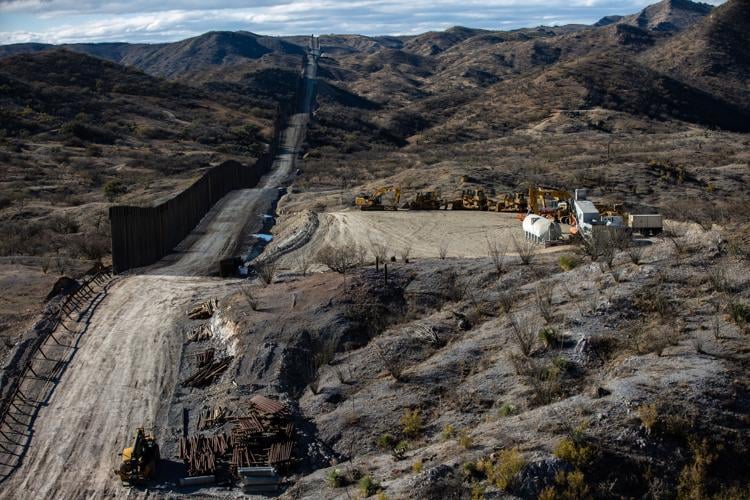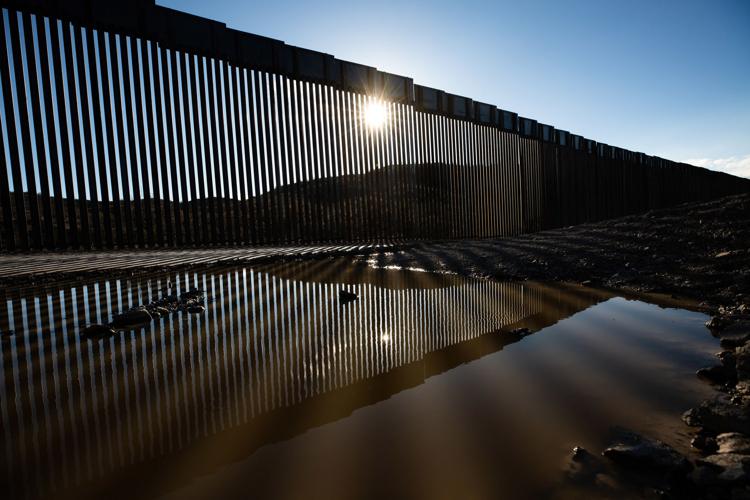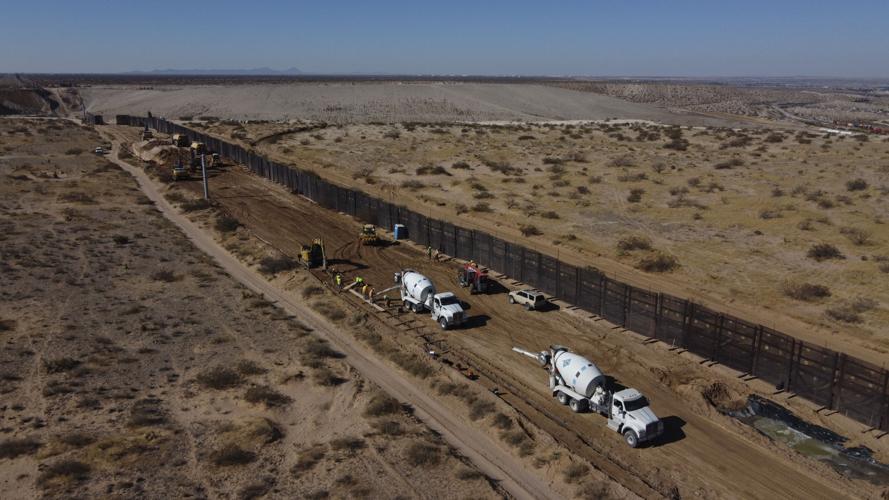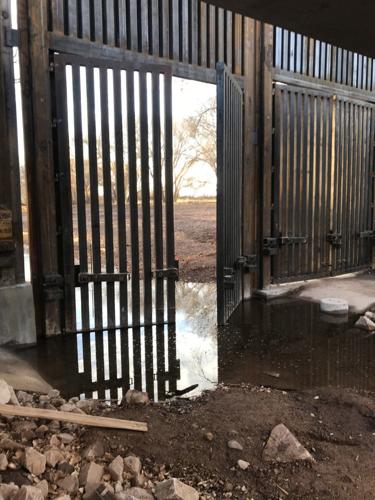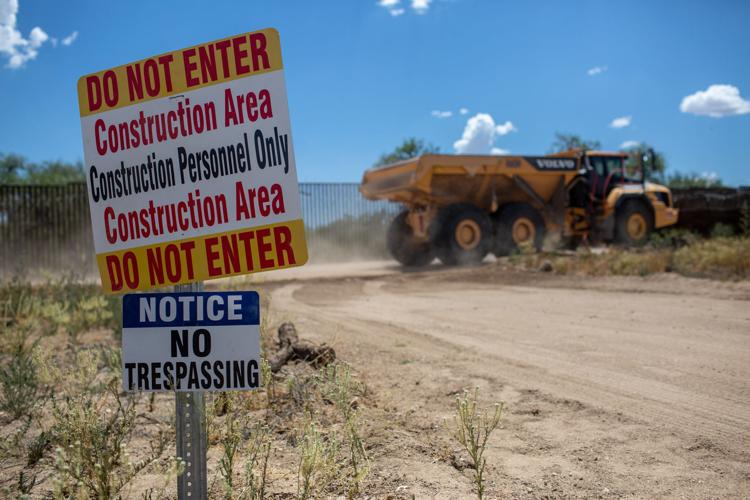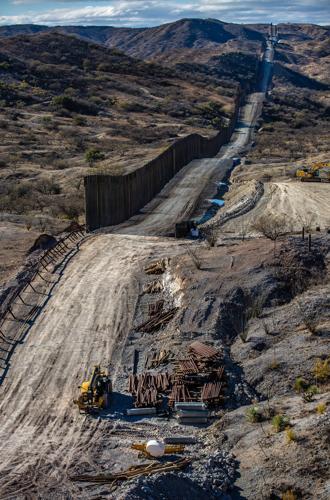In the beginning was the word, and the word was “wall.”
“Not fence,” the counselors advised. “Wall.”
When the man talked of the wall, the people stirred, they shouted, they chanted: “Build the wall! Build the wall!”
The man noticed the stirring. So the word became a promise, and the promise became a test of loyalty. The test became a campaign commitment, and the commitment became a jobs program.
Now, you can stand in the striped shadow of 30-foot bollards in the wilds of Southern Arizona. The steel is driven into concrete poured feet into the ground, and topped with metal plates.
It looks intimidating, as intended — a big barrier, slashing straight across the land. A border wall.
But it’s not just that. It’s a monument. It’s a monument to a mnemonic device made into a moving motto — “build the wall.” An idea with an urgent, fleeting life, just ended.
It’s a monument to the word.
“Nobody builds like Trump”
Sure Donald Trump wanted to put up a border barrier. All the GOP candidates did.
But that wasn’t good enough, brash enough to make him stand out.
“Everybody called it a fence,” said Sam Nunberg, one of Trump’s early campaign advisers. “Trump said ‘fence’ — he kept calling it a fence.”
In summer 2014, Nunberg and fellow adviser Roger Stone massaged the messaging.
“The issue was how to get him to continue to talk about immigration,” Nunberg said in a pair of interviews. “Remember, when I was working for him, he was not using prepared remarks, he was not using the teleprompter. He was doing what we called the ‘Donald Trump Variety Show.’ ”
“He had frequently said, ‘I’ll build a fence’ or, ‘I’ll build something at the border.’ Come the summer of 2014, I had heard him say once at a meeting, ‘Nobody builds like Trump.’ ”
That got Nunberg’s gears turning. He came up with a three-phrase mantra for Trump to repeat on the stump: Build a border wall, nobody builds like Trump, Mexico will pay for it.
“The wall explanation was: Everybody else said ‘fence,’ you’re going to say ‘wall’ — bigger, stronger.”
Trump wasn’t convinced, until he heard the crowd response, Nunberg said. By the time Trump announced his candidacy in June 2015, it was becoming a highlight of his speeches.
“I would build a great wall,” he said after coming down that golden elevator for his announcement. “And nobody builds walls better than me, believe me. And I’ll build them very inexpensively. I will build a great, great wall on our southern border, and I will have Mexico pay for that wall. Mark my words.”
The precise justification for the wall, the explanation of how Mexico would pay for it — these details were immaterial to the marketing.
As the campaign progressed, the crowds would chant in response: “Build the wall! Build the wall!”
It didn’t matter that most people in the crowds had never seen the U.S.-Mexico border. It didn’t matter that Nunberg himself, a born-and-bred Manhattanite, had never seen the border when he came up with the slogan.
The word had power.
“We don’t need a great wall of the U.S.”
Then, incredibly, Trump won.
And when he got to governing, people around him turned pragmatic and cautious. Even his closest allies on border issues started reining in expectations about the border wall.
Homeland Security Secretary John Kelly said it was “unlikely” the wall would stretch “from sea to shining sea” as Trump seemed to promise his supporters.
Brandon Judd, the head of the Border Patrol agents’ union and a top Trump ally, also lowered the priority of the wall. Testifying in March 2017 to the Senate Homeland Security and Governmental Affairs Committee, Judd said to then-Sen. Claire McCaskill, a Missouri Democrat:
“As far as the wall goes, Sen. McCaskill, I agree with you 100%. We don’t need a great wall of the United States. We do not need 2,000 miles of border wall. I will tell you, however, that a wall in strategic locations is absolutely necessary.”
He went on to list other priorities of the agents’ union: lowering attrition, establishing pay parity with other agencies, improving morale. Those were the nitty-gritty concerns of line agents.
The union emphasized this in a written statement that same month: “Although we welcome these additional resources, we fully understand that resources for border security are not unlimited. Tough choices will have to be made as to which investments will have the greatest impact on border security, and this includes funding for ‘the wall.’”

A border wall report concluded CPB did not use “well-documented methodology to identify” which areas “would best benefit from physical barriers.”
Supporting the wall became a loyalty test
The president plowed ahead. The Department of Homeland Security commissioned eight prototypes of border walls, built by contractors near San Diego. Military specialists tested them, Trump visited them. But they were left aside, eventually demolished, and the wall idea drifted.
Until April 2018. Then, word of a caravan of thousands of migrants, walking together from Central America for safety, reached the White House.
“Mexico is doing very little, if not NOTHING, at stopping people from flowing into Mexico through their Southern Border, and then into the U.S.,” Trump tweeted. “They laugh at our dumb immigration laws. They must stop the big drug and people flows, or I will stop their cash cow, NAFTA. NEED WALL!”
A series of caravans headed toward the United States that year. Trump sent in the military and ratcheted up his pressure for the wall, especially after the Republicans lost control of the House in the November 2018 midterm elections.
Congress offered $1.3 billion toward constructing new border barriers in December 2018, but Trump wanted $5.6 billion. In the end, he shut down the federal government for a month over the difference.
Supporting him on this became a loyalty test. And the agents’ union, among others, proved loyal, although the rank-and-file wouldn’t receive checks in the shutdown.
Judd said at an impromptu White House news conference with Trump in January 2019: “Anywhere that we have built walls, they have worked. … We need those physical barriers, and we appreciate President Trump and all of his efforts in getting those physical barriers.”
The days of tempered support were over.
Selling the idea with a new slogan
So, the rush was on.
Trump would build a border wall like his presidency depended on it, no matter what Congress said. He would enlist his allies and mobilize the government to fulfill the motto’s promise.
On Feb. 15, 2019, Trump declared a national emergency at the border and began siphoning billions of dollars from the Pentagon to build more wall, faster.
Opponents, especially environmental advocates, complained and sued. The wall blocked millennia-old wildlife routes and obstructed water flows. But the Supreme Court wouldn’t stop it.
Trump enlisted DHS officials to sell the idea to a skeptical public. He needed the help.
In January 2019, a Gallup poll showed that 60% of Americans opposed building significant new border wall. Just 40% favored the wall building, but among them were Trump’s avid supporters, his “base,” who demanded the wall at his rallies. They deserved their reward.
Customs and Border Protection set to work selling the idea. They came up with a catchphrase to sell the idea that itself began life as a motto: “Walls work.”

The gate in the border fence across the San Pedro River at the Arizona-Mexico border was left open early last week to allow water and debris to pass through.
“The border wall has created a safer environment for our agents and for the migrants,” said Tom Reber, a supervisor in Border Patrol’s El Centro Sector. It was one of many online testimonials by DHS employees posted with the hashtag #WallsWork.
Where exactly the wall went up didn’t matter much as long as steel was plunging into concrete.
An Office of Inspector General report from July 2020 concluded CBP “did not use a sound, well-documented methodology to identify and prioritize investments in areas along the border that would best benefit from physical barriers.”
Basically, it said, CBP shifted things around without explaining why. Chief of the U.S. Border Patrol Rodney Scott acknowledged those shifts in an Oct. 29, 2020, event celebrating the completion of 400 miles of border wall, five days before the election, the McAllen Monitor reported.
“We elected to go ahead and shift down to a lower priority, because I can make a difference there,” he said, adding, “and then take those human resources, agents and technology, and shift them into another area where I was going to have more challenges of building a wall.”
They built the wall where they could, not necessarily where they thought it was most needed. They could do it fastest on federal land, starting in the flatter places, then blasting into the mountains. They waived environmental laws, signed contracts and pushed ahead.
A deadline was looming: Nov. 3.
Words work
Words work, too, it turns out. The motto had become a political slush fund and jobs program.
CBP handed out contracts freely, even to build walls on private land in Texas that the government hadn’t bought. Fisher Sand and Gravel, owned by a Trump supporter who courted the president on TV, won some of the richest contracts — $1.35 billion for 45 miles of border between Nogales and Sasabe. That’s $30 million per mile.

Signs warn against entry at the border wall construction area east of Sasabe, Arizona where Fisher Sand and Gravel was installing new wall new wall segments on July 16, 2020.
Southwest Valley Constructors built an elaborate system of gates across the San Pedro River, blocking one of the state’s prime wildlife corridors.
Even when the election was over and Joe Biden had won, they pushed onward, faster and faster, making money and adding miles while they could, reaching 450 in January. Trucks flew by all night on the normally desolate roads of Cabeza Prieta National Wildlife Refuge.
After Biden was sworn in as president and ordered a pause to all wall building, work continued in Coronado National Memorial, for wall that may never be built. Biden had given a seven-day grace period.
Finally, last week, the heavy machinery was idle. A dozen pieces sat in a scraped-clear lot in a remote spot south of Arivaca on Friday. The wall ends there, but the road continues, blasted through hillsides, east to the end of Sycamore Canyon in the Pajarita Wilderness.
When work finally stopped, the complaints began that Biden was killing jobs.
“Conservatively, it’s going to cost 5,000 jobs,” the outgoing commissioner of CBP, Mark Morgan, complained to Breitbart News. “It’s gonna cost them their livelihood.”
It’s as if it were inconceivable that there could be a more helpful way to spend $15 billion than this.
And with that, the evolution, it seems, was complete.
The mnemonic device that became a motto and a promise and a loyalty test and a campaign commitment has taken what may be its final, inevitable form: money.
And what’s left on the border manifests all those meanings. The scraped earth, the blasted rock, the wide roads through wild lands, the piles of debris and towering bollards — one after the other into infinity.
All from the word.
Photos: Border Wall Construction Over the San Pedro River
San Pedro River Border Wall Construction
Updated
A worker continues construction on the U.S./Mexico border fence over the San Pedro River near Hereford, Arizona on July 8, 2020. Behind him is Mexico.
San Pedro River Border Wall Construction
Updated
Construction continues on the U.S./Mexico border fence over the San Pedro River near Hereford, Arizona on July 8, 2020. Cement blocks are placed within a trench dug across where the river flows.
San Pedro River Border Wall Construction
Updated
Construction continues on the U.S./Mexico border fence over the San Pedro River near Hereford, Arizona on July 8, 2020. Cement blocks are placed within a trench dug across where the river flows.
San Pedro River Border Wall Construction
Updated
Construction continues on the U.S./Mexico border fence over the San Pedro River near Hereford, Arizona on July 8, 2020. Cement blocks are placed within a trench dug across where the river flows.
San Pedro River Border Wall Construction
Updated
Construction continues on the U.S./Mexico border fence over the San Pedro River near Hereford, Arizona on July 8, 2020. Cement blocks are placed within a trench dug across where the river flows.
San Pedro River Border Wall Construction
Updated
Construction continues on the U.S./Mexico border fence over the San Pedro River near Hereford, Arizona on July 8, 2020.
San Pedro River Border Wall Construction
Updated
Construction continues on the U.S./Mexico border fence over the San Pedro River near Hereford, Arizona on July 8, 2020. Cement blocks are placed within a trench dug across where the river flows.
San Pedro River Border Wall Construction
Updated
Construction continues on the U.S./Mexico border fence over the San Pedro River near Hereford, Arizona on July 8, 2020.
San Pedro River Border Wall Construction
Updated
Construction continues on the U.S./Mexico border fence over the San Pedro River near Hereford, Arizona on July 8, 2020. Cement blocks are placed within a trench dug across where the river flows. Mexico is on the right.
San Pedro River Border Wall Construction
Updated
New U.S./Mexico border fence near the San Pedro River near Hereford, Arizona on July 8, 2020.
San Pedro River Border Wall Construction
Updated
New U.S./Mexico border fence near the San Pedro River near Hereford, Arizona on July 8, 2020. "Made in the USA" is seen on the bollard fence.
San Pedro River Border Wall Construction
Updated
Construction continues on the U.S./Mexico border fence over the San Pedro River near Hereford, Arizona on July 8, 2020. Cement blocks are placed within a trench dug across where the river flows.
High-ranking border officials come to Tucson to praise Trump, blast Twitter
UpdatedTwo high-ranking border officials came to Tucson on Monday to tout President Trump’s border policies and to berate Twitter for locking one of them out of their account last week.
Monday’s news conference was the latest in a string of recent visits by Trump administration officials to Arizona, which could become a key swing state in the presidential election. Both President Trump and Vice President Mike Pence visited Arizona in recent weeks, as did Education Secretary Betsy DeVos and Secretary of the Interior David L. Bernhardt.
Democratic candidates Joe Biden and Kamala Harris also visited Arizona recently.
Mark Morgan, the senior official performing the duties of commissioner of Customs and Border Protection, and Ken Cuccinelli, the senior official performing the duties of deputy secretary of the Department of Homeland Security, flew over the border area south of Tucson in a helicopter before landing at Davis-Monthan Air Force Base late Monday morning to speak to reporters.
Both officials were effusive in their praise of President Trump’s border policies, particularly the construction of roughly 400 miles of 30-foot-tall border wall and the sharp drop in border apprehensions since last year when hundreds of thousands of asylum-seekers arrived at the U.S.-Mexico border.
Cuccinelli cited “unprecedented achievements” by the administration, which “put its promises into action.” He praised Trump’s “relentless leadership and drive.”
Among those achievements was the seizure of more hard drugs, such as fentanyl and methamphetamine, in the last four years than in the previous eight years.
Video provided by the Yuma Sector Border Patrol shows a group of 108 Central American migrants being dropped over the U.S.-Mexico border wall …
The administration “took bold action” to address the crisis at the border last year and listened to what Border Patrol agents said they needed at the border, Morgan said.
“To me, as acting commissioner, this is very much an apolitical statement when I say that this president listened and this president delivered. That’s just a fact,” Morgan said.
Neither official seemed concerned about the propriety of DHS officials making what could be seen as a campaign stop for President Trump hours before the polls open.
When asked why the officials came to Tucson the day before the presidential election and whether the visit could be viewed as an effort to sway voters, Cuccinelli said he hadn’t been to the Arizona border yet and the state was “on the cycle to do.”
“We don’t stop doing our job because there’s an election coming or going and this is part of that whole effort,” Cuccinelli said.
The second focus of Monday’s news conference was a tweet posted by Morgan on Oct. 28, which prompted Twitter moderators to take it down and lock Morgan out of his account for about 20 hours.
Morgan’s Oct. 28 tweet said that CBP and the Army Corps of Engineers “continue to build new wall every day. Every mile helps us stop gang members, murderers, sexual predators, and drugs from entering our country. It’s a fact, walls work.”
In response to Twitter blocking Morgan’s account, Acting DHS Secretary Chad Wolf wrote a letter to Twitter executives.
Twitter moderators emailed Morgan, saying, “You may not promote violence against, threaten, or harass other people on the basis of race, ethnicity, national origin, sexual orientation, gender, gender identity, religious affiliation, age, disability, or serious disease,” Wolf wrote in the letter.
“There was no reason to remove Mr. Morgan’s tweet from your platform, other than ideological disagreement with the speaker,” Wolf wrote. “Such censorship is disturbing.”
Construction crews have begun laying the foundation for a 30-foot-tall border wall across the San Pedro River in Cochise County.The long-delay…


